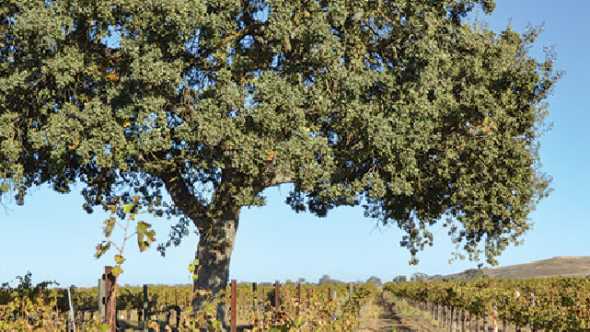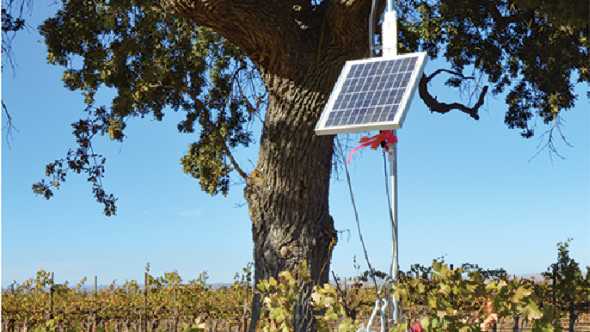#Recipe #Foody

Populations of valley oak trees along California’s Central Coast are declining. Bill Tietje and his team are studying lone oak trees in vineyards like this one to understand their wildlife value and agricultural benefits to encourage growers to leave them on their property and possibly plant more.
Photo by Bill Tietje
There’s something iconic about driving through California’s Central Coast and seeing giant oak trees scattered across the landscape. Throughout history, however, not all Californians have appreciated the majesty and value of these trees. During the first half of the 1900s, many oak trees were removed to make way for agriculture and urban development. This, together with poor regeneration, contributed to declining populations of some of California’s 20 native oak species, most notably the valley oak.
Bill Tietje has studied California oaks for more than 30 years as a University of California Cooperative Extension Natural Resource Specialist. Though oak tree removal has slowed, Tietje still sees a need to encourage growers to keep, and even to plant, new oaks on their properties. To do so, he and co-researchers needed to better understand the benefits of the trees in agricultural systems.
Many of the vineyards along California’s coast were developed during the 1990s. Some growers left the oaks on their properties, even isolated trees.
“We wanted to understand more about the wildlife value of the trees that many of the grape growers left within their vineyards,” Tietje said. “Although growers can incur a cost from the trees, we felt that if we could demonstrate their environmental value ― as well as the benefits of the trees for growers ― the growers would have increased incentive to retain and maintain them.”
To study the oaks, Tietje worked with Ted Weller, a Research Scientist at the U.S. Forest Service’s Pacific Southwest Research Station, and University of Washington graduate student Anne Polyakov. The research team used Google Earth to locate 14 vineyards in San Luis Obispo County with isolated trees at least 100 meters from vineyard edge, body of water, patch of trees, or road. Within each of the study vineyards, they also picked an open site, 100 meters from the tree site and surrounding factors.
“We wanted to understand effects due to the tree, not any surrounding factor,” Tietje said.
GOING BATTY
When it came to evaluating the impacts of the oak tree on wildlife, bats were a natural choice. While birds can damage or eat grapes, the bats, at least in the study area, eat only insects. Tietje was curious to see if the oaks drew them into the vineyards where they could potentially help the grower by reducing the numbers of insect pests. To determine bat activity and species, the study team set up microphones at the edge of the tree’s canopy and the open site within the vineyards.
“Indeed, the number of bat calls was more than double at the trees than in the open areas of the vineyards,” Tietje said. “The results showed that a group of bat species called woodland-adapted bats, which typically would not be in a large treeless area such as a vineyard, were frequenting the trees within the vineyards. The trees were bringing woodland bats into the vineyard, thereby increasing the biodiversity of the vineyard area.”

Vineyard tree sites and open sites within vineyards were equipped with identical bat echolocation recording systems. In addition to being placed 100 meters apart from each other, the sites also were located 100 meters from a vineyard road, irrigation reservoir, or building to lessen the chance of human influence.
Photo by Bill Tietje
In addition to bringing bats into a vineyard, oaks store carbon and provide “stepping stones” that wildlife can use while moving across the agricultural landscape, such as from a feeding site to a roosting site.
In addition to their environmental benefits, Tietje emphasizes oak trees can be beneficial for growers as well. He is continuing to research what insects the bats are eating. If they’re drawn to vineyard pests, growers may need to use fewer chemical treatments on their grapes.
GROWER SEES VALUE
Jerry Reaugh is one of the grape growers that allowed access to his vineyard for the study. Though he wasn’t experiencing many pest issues with his grapes, he sees the value of keeping an oak tree.
“It adds beauty to the landscape and great ecological value without being cumbersome to growers,” he said. “It’s a win-win.”
Wine country visitors share Reaugh’s opinion of the oaks.
“People find oaks across the rural landscape to be aesthetically pleasing, attracting tourists to the wine country,” he said. “Removal of trees being very controversial, keeping and planting oaks is also a political plus for growers. Oak trees, especially valley oaks, are icons in this area and highly desired.”
Tietje is looking at finding ways to continue to increase the benefit of the trees in agricultural landscapes without sacrificing agriculture production or economics.
“I encourage the growers to retain and maintain these trees and to plant oak trees, especially valley oaks, in suitable areas around the vineyard,” he said. “Planting even one tree a year can make a large contribution over the long term toward increasing their populations. Growers have water and agricultural knowledge and staff to help with planting and maintenance until trees get going. It’s a natural fit. The bottom line: it can be a win-win for the environment and the grower.”
Kathie Zipp is a regular contributor to American Fruit Grower and Western Fruit Grower magazines on a variety of subjects from crops to production. She is a freelance writer residing in Parma, OH. See all author stories here.
Recipe
via https://www.DMT.NEWS
Paul Rusnak, Khareem Sudlow
- Share:



0 comments